Four years later, reflections on covering the Jerry Sandusky trial

On Nov. 5, 2011, Jerry Sandusky was arrested on child sex abuse charges, and as the case unfolded in the subsequent months, Penn State University nearly imploded. I covered the events as a reporter for ABC News from start to finish.
1. Questions of Faith
Behind the courthouse, in the glaring June sun, a dozen photographers and reporters watch silently as Jerry Sandusky, the man accused of molesting at least 10 children over a 15-year period, laughs and helps shuffle boxes of documents from a cart into the waiting SUV. It is the third day of testimony in his trial — damning, graphic, horrific testimony that seems sure to return a guilty verdict.
Clad in a dark suit that contrasts his shock of white hair, Sandusky stands more than six feet tall and 250 pounds — a football player’s body with a grandfather’s soft demeanor. As he lifts the boxes of files, Sandusky smiles at the waiting reporters and looks around helplessly for direction from his attorney. He seems almost unaware of what has been happening inside the building behind him each day. It’s hard to imagine him directing a football play, a children’s charity, or even his own vehicle. In fact, he is driven everywhere by his attorney. He is hapless, a silly old man. Or at least that is the idea being presented to us here behind the courthouse.
Of course, there is a disconnect there. The crimes he is accused of committing, and which have been detailed inside the courtroom each day, would have to have been carefully concealed from the world if they were to be committed. The prosecutors call him calculating, an “expert” pedophile, arrogant, bold, and most of all, a monster. Does that description fit? Is he a big, stupid oaf, or a cold, evil predator? That is the question that Joe Amendola, Sandusky’s lanky defense attorney, is trying to pose to the jury. But that question, it turns out, will be shockingly easy to answer.
No, our central question, and what amounted to our central preoccupation in Centre County, Pennsylvania, in June 2012, would come to be the icon, the demigod, Joe Paterno, and what he knew and when he knew it.
2. The Problem of Evil
When Sandusky was charged, the Pennsylvania Attorney General released the indictment quietly on a Friday afternoon, purportedly by accident. Sandusky and two other top Penn State officials were arrested on Saturday, and by the time I got into the office Monday morning, the national media were just slowly catching onto what had happened in State College over the weekend.
“Curry,” my editor said. “Why don’t you keep an eye on those Penn State officials?”
I had no idea what she meant. I nodded and scribbled a note on my pad: Penn State?
I printed out and read the indictment at my desk, the words blurring in front of me as I began to understand what I was reading. It described how in 2001, an assistant coach at Penn State claimed he had seen the retired defensive coordinator naked with a child in the locker room showers. The young assistant told the university’s head football coach — Paterno — who in turn told his boss, the Athletic Director, who told the Vice President, who then told the President. Five men, in all, were made aware that Sandusky had done something inappropriate with a boy in the university’s locker rooms, yet none of them picked up a phone to call police, according to the indictment. This was a central point of the case, a point that would in time eat away at the the university’s community.
More immediately powerful to me in those first moments, though, was the detailed recounting of Sandusky’s sexual relationships with eight boys. The indictment was filled with graphic descriptions of intimately horrific behavior between a man I’d never heard of and boys whose names would not be made public. I sat queasy at my computer, flipping through the pages. I was the first in our newsroom to read what soon the rest of the world would have to hear about over and over for 10 months, and I had no idea how to interpret it or begin to make sense of it. What follow-up questions do you ask about a man who violently and sexually attacked 9-year-olds? It was so far outside of my reach, my normal everyday existence. It was, I would later think, an eerie, solitary encounter with evil.
3. Teachers to Suit Their Own Passions
The drive to Penn State is daunting. The highway curves and climbs over the foothills of the Allegheny Mountains and then descends sharply into the bowl-shaped land known as Happy Valley, though its geographical name is familiar too: Nittany Valley, home to the Nittany Lions. The road into town drops visitors right at the doorstep of Penn State University, sitting on the valley floor, the faint echo of student voices chanting, “We Are! Penn State!” bouncing off the mountain walls.
You know you are there when you see the stadium. It rises up, gothic and vaguely ominous, like an ancient cathedral in the middle of the city. There, inside the stadium’s walls, a small tough man with rolled up pants and thick black glasses led the football team each Saturday for 61 years. It was a lifetime and then some for the head of a football program, and enough time for Joe Paterno’s reputation and persona to grow so large that its enormity seemed to compete with Beaver Stadium itself. That is, if you could separate the two. Beaver Stadium was synonymous with Joe Paterno, and Paterno, after six decades in power, was synonymous with Penn State University.
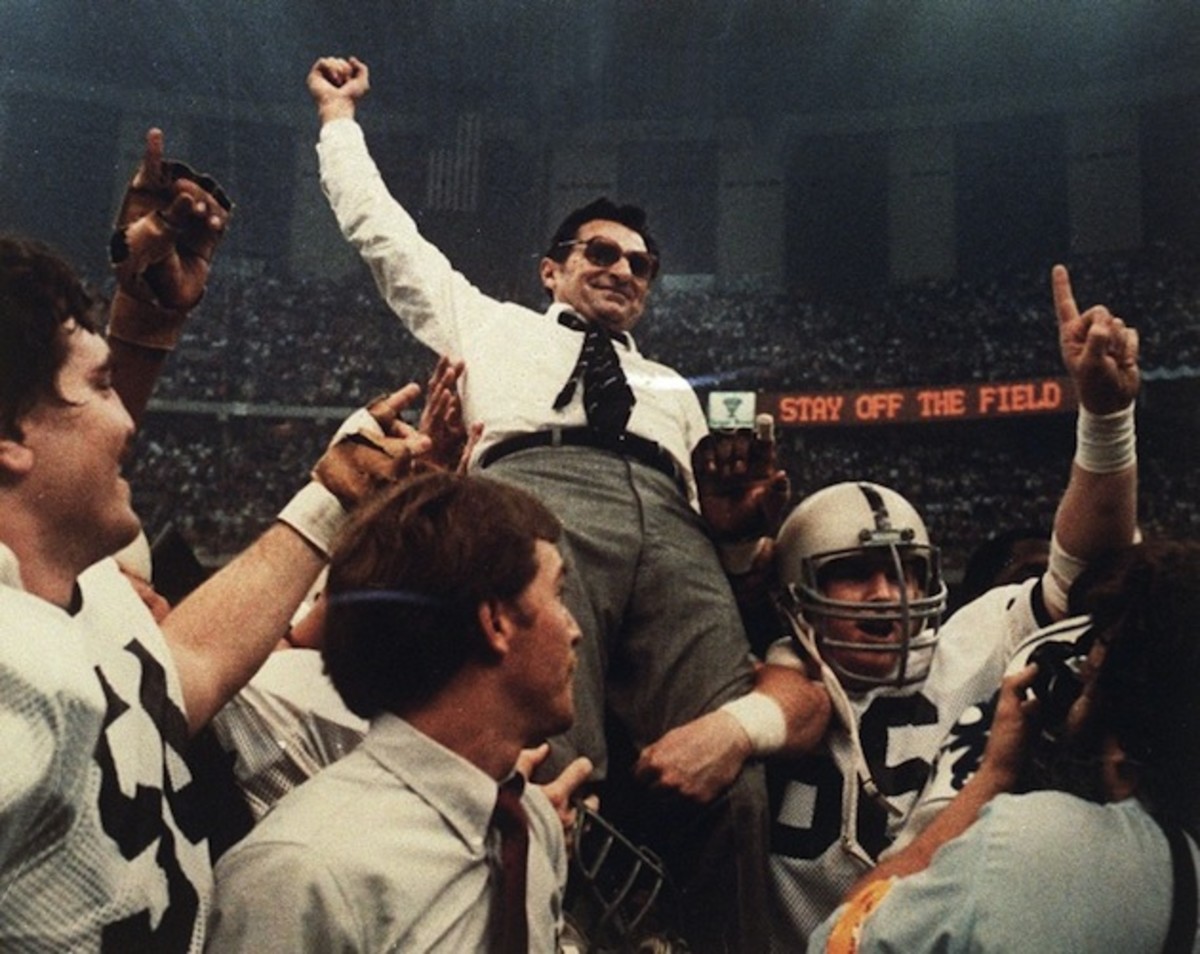
“Joe Pa,” as he was affectionately dubbed, had taken Penn State from a no-name athletic program to a Division-I Big Ten powerhouse during his tenure. The school became nationally known for football, and Paterno’s rising tide lifted the boats of the university’s academics, athletics, community, and, in fact, the entire state. Enrollment increased, as did Penn State’s profits. Paterno, in effect, was at least partially responsible for thousands of students attending the school, for hundreds of faculty members being hired, and thousands more staff becoming employed as the campus grew. His incredible success was so important to the reputation, fundraising and academics of the institution, that football had become arguably the most powerful “department” on campus. At the head of that department, and at the top of the university’s power structure, sat Paterno.
Paterno, for his part, didn’t act like a powerful sports hotshot. He owned a modest ranch home only a block away from school, in a small middle-class neighborhood with nice front lawns. He walked to home games across the fields of the campus he loved so much, and donated back millions to help improve the academics of the university. Though he was, in some sense, the architect of his surroundings, he appeared, day-to-day, as merely a humble occupant, too.
It was this disparity that earned Paterno the adoration of his community. Despite his power, the head coach represented the community’s values: honor, success, education, humility. Though he grasped the school’s economic reins, he also remained its moral compass. Or so it seemed, anyway.

As he grew older at Penn State, coaching generation after generation of players, Joe Pa became the school’s vigorously admired grandfather. What began as respect and admiration blossomed over the years — as sports fandom sometimes does — into something resembling deity status. People were so committed to the idea of Paterno being a good man and a good leader that his stature grew, both in the community and nationally. He became the selling point for recruiters trying to convince 18-year-olds to play for Penn State, to learn and grow under his mythical leadership.
The students and staff and fans of Penn State saw in their demigod something they could aspire to, someone in whom they could place their belief that anyone with a good work ethic and good values could achieve what he achieved. It was seductive, and they were evangelized. Each and every Saturday the faithful turned out in droves, from all corners of Pennsylvania and beyond, to see their man in action.
“We are,” the student section shouted during home football games. “Penn State!,” the stadium responded. “We are,” they said, “Penn State!” In blue and white t-shirts emblazoned with Paterno’s face, carrying cardboard cutouts of life-size Paternos, painting their chests blue with the white words “JoePa,” the students worshipped each weekend. And cast in bronze outside the stadium doors was the statue of the man himself, erected well before it could be called a posthumous monument. Before games, after games, and often during the long stretches of off days in between games, fans lined up to get their picture taken with the bronzed version of their idol. The statue showed classic Paterno, cuffed pants and all, in mid-stride, hand raised in the air, his pointer finger above his head: No. 1. Smaller statues of players stood next to the golden coach, following his lead.
Two weeks before Sandusky was charged, Paterno became the winningest coach in the history of college football. He had a library named after him on Penn State’s campus, a fellowship named after him at his alma mater, Brown University, and an untouchable legacy of being — as the statue had it inscribed — an “EDUCATOR COACH HUMANITARIAN.”
4. Crucifixion
Four days after Sandusky’s arrest, Penn State University, if not quite literally, imploded. The media descended upon State College, reporting breathlessly on every meeting of the Board of Trustees, digging for answers to all of the questions that remained, the biggest ones being what Joe Paterno knew, when he knew it, and what did he do about it.
On Wednesday night, the cameras flashed and students watched helplessly as a telegram was delivered to Paterno’s house by messenger. The message inside was clear: You’re fired.
Joe Pa, fired.
The students recoiled from the shock. Thousands of them, Paterno acolytes, poured onto College Ave. in Penn State sweatshirts, exploding with rage that their hero had been brought to such an unseemly end. It was those neatly-groomed, soft-spoken teenagers from Pennsylvania — the same bunch that saw fit to tip over a news van — who screamed, raged, laughed, cried and crowd-surfed. They drank beers and threw the cans at reporters who watched, mystified, as the mob scene morphed into a sort of late-night pep rally.
“We are,” they shouted, “Penn State!”
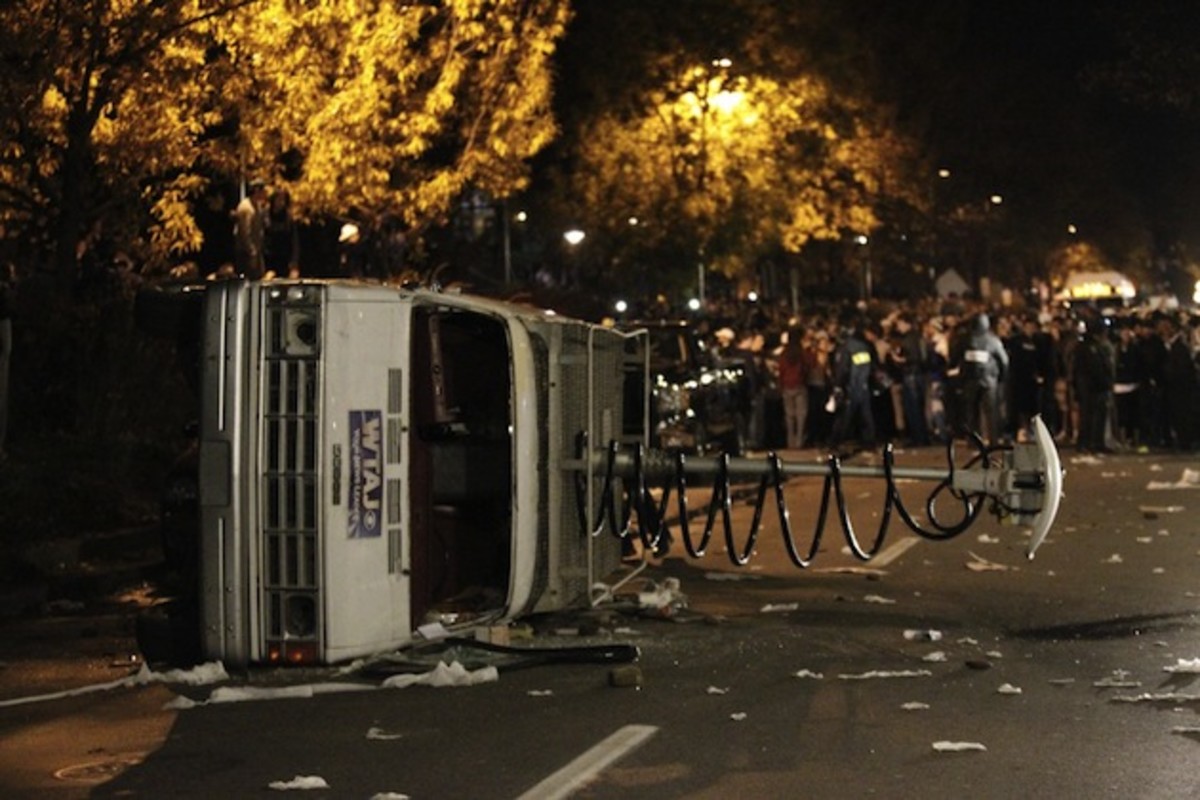
But beyond the student body, a schism emerged among the faithful. Stop a moment and think, the fervent believers pleaded: How would you feel if the world said the one thing you believed in was a lie? Surely, Joe Pa, the Joe Pa, could not have really known about Sandusky’s crimes, and done nothing to stop them.
On the other side, the agnostics: What did he know? Why didn’t he report it? He could have done more. He was protecting Sandusky, protecting the football program, protecting the university, protecting his kingdom. He should be fired. should go to jail. Did we misjudge him? What should we believe?
The believers rallied. They lined up a hundred yards deep at the side of the Paterno statue, waiting for their pictures to be taken with the memorialized version of the man who lived just up the block. They held a quick rally, a prayer before a game. “Remember victims of child abuse,” they said quietly in front of that football cathedral that rose up behind the bronzed god enshrined below.
Then they shouted, “We are! Penn State!”
5. Beyond a Shadow of a Doubt
The media, of which I was a member, was criticized for making the case about Paterno, when the one who committed such heinous crimes was clearly Sandusky. But the doubt that ate away at the State College community was not about Sandusky and what he did or didn’t do. No, the community came to a swift conclusion about Sandusky.
The question that burned a hole into Centre County was what Paterno, the people’s hero, knew and did. Not only because of the moral questions raised for all of us (how far do we have to go, how proactive do we need to be to be morally upright?) but also because of who he was. The case mattered because it involved a man who was literally an institution.
On our best days, we reporters try to live up to our duties as surrogates for the public: seeing things up close, asking difficult questions, getting to the truth, informing the community. And in State College, we came to see and feel, I think, the community’s confusion, disbelief and eventual anger toward Paterno, a man who did so much good, a man who the community so blindly believed in, a man who uplifted them and was at times their North Star, and who, it seemed, apparently allowed this to happen.
6. Death of a Man
Two months after he was fired, Joe Paterno was dead.
Can you believe that? Two months later, with all those questions still unanswered, with all the confusion and horror descending over the house and community that he built, the god was no more. Paterno succumbed to lung cancer, and the talking heads suggested of the media, “They killed him, he just could not live without football.”
But I’ll be damned. Everything we knew suggested that Paterno knew about Sandusky. And then he died before anyone could be sure of it, and before anyone could be held accountable.
I’m not angry. Or maybe I am.
It doesn’t matter, he was dead. He’s still dead.
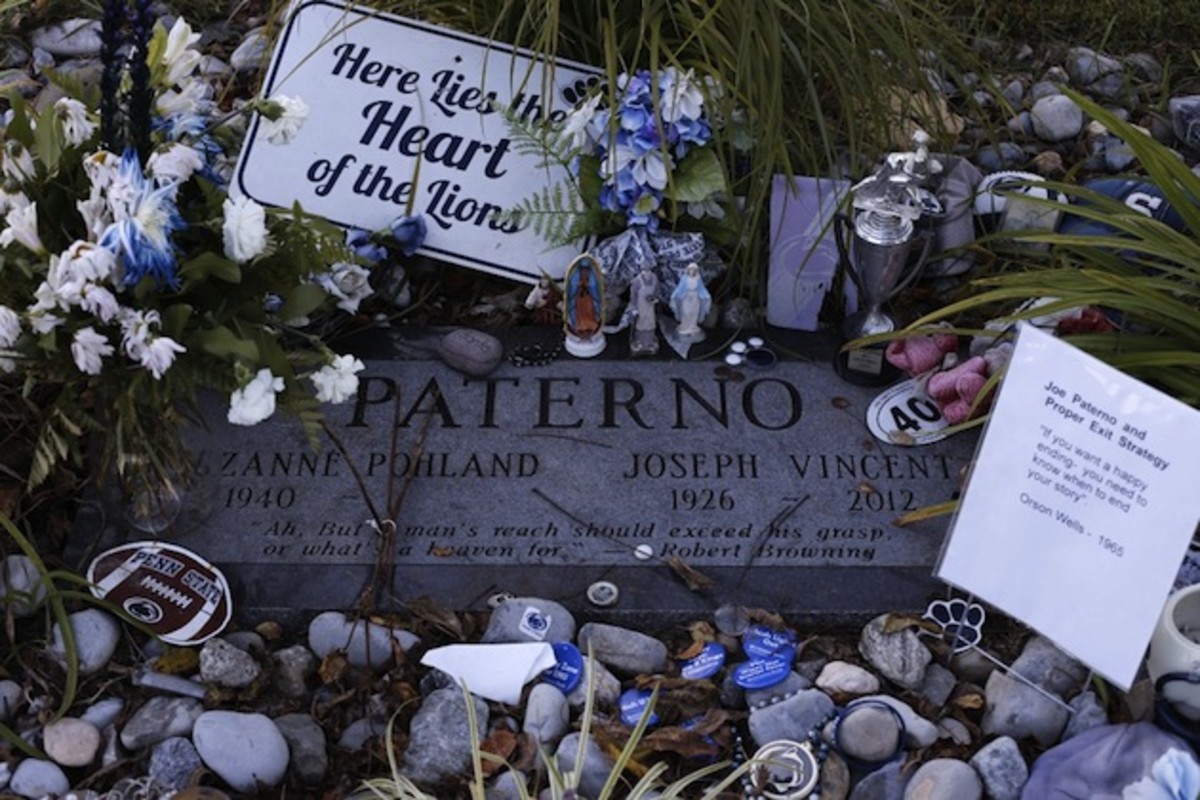
That winter, the story lost interest with readers. Because Joe Pa was dead.
Even now, nearly four years after his death, much of the interest in the story that still populates blogs and Twitter, and occasionally provides fodder for news reports, focuses on Paterno and what he knew. A passionate core of Paterno fans beats ceaselessly (and fruitlessly) to clear their guy’s name, to poke holes in investigations that have long since ended.
The real story, though — the story about the crimes and the victims — seems to have receded into background noise. And that makes me sad.
7. The Separation of Church and State
We returned to Centre County the following June.
Ten miles down the road from Penn State, past rolling fields and farmhouses and the Centre County Correctional Facility and the Rockville State Prison, lies Bellefonte, the county seat. There, we were met by a gurgling stream and waterfall, a park full of ducks eating ripped pieces of bread, a couple of old train cars with the letters B LLEFONT TR IN dissolving into rust. A quiet town. As we turned up the main road and away from the stream, we saw it, the Centre County Courthouse, an imposing white alabaster structure that would be the center of our universe for the next few weeks.
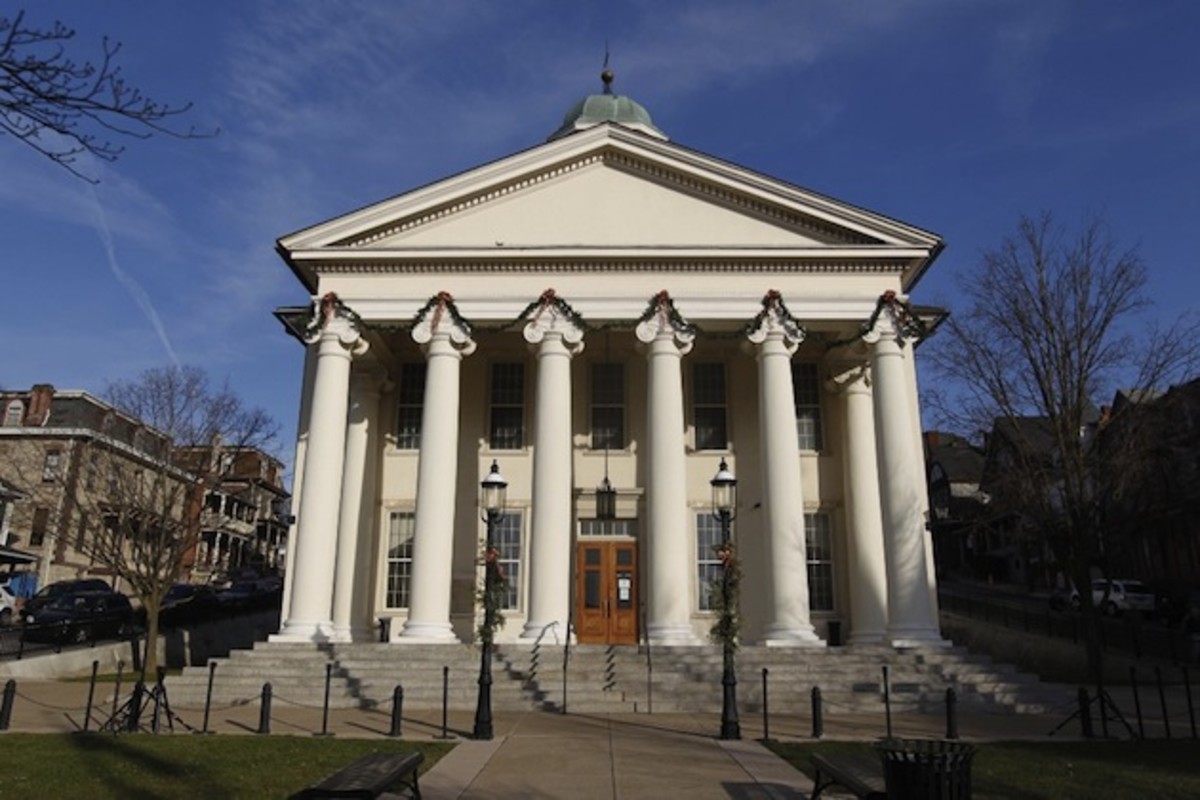
ABC arranged for a workspace on the second floor of the Beard Law Firm, a beautiful Victorian building with large windows and wooden floors, tall ceilings and slow moving ceiling fans. The office downstairs — much like most of the office and retail space in town, for that matter — was vacant during our stay. The entire town was dotted with “For Rent” or “Going Out of Business Sale” signs.
There were two places in town that were busy, though: Cool Beans coffee shop and Elks Lodge No. 1094. The hip young mom and her sweet teenage daughters who run Cool Beans catered to the up-and-comers in town, the ones who want to try pickled radishes made by local artisans or fair-trade coffee flown in from Colombia. The Elks Lodge, predictably, was populated by men in their fifties and sixties, likely retired, sitting on the porch and rocking back and forth during the day. At both places, Bellefonte residents talked about the trial.
“I can’t wait to have my parking spaces back,” one said.
“I can’t wait until that Jerry Sandusky is put away for good,” said another.
“Get the hell out of our town,” a third growled at me.
Bellefonte was not as rich as State College — which is populated by well-off faculty and staff — but it was not struggling quite as much as some nearby towns in Pennsylvania, either. Lewistown and Millersburg and Snow Shoe and Lock Haven are names we heard throughout the trial; some of us had seen them when we were making the drive from New York. They are small towns with row houses clinging to the side of hills, floors sloping and paint peeling, cars rusting on the streets out in front. They are 30, 50, or 60 miles away from State College, former industrial towns with affordable housing and some jobs, at restaurants and bars and malls. In Clinton County, where one boy lived, more than 15 percent of the population fell below the poverty line, and the percentage of single-parent households was nearly double the rate in Centre County, where State College is located.
The prosecution pointed it out over and over again, and how could they not?
“Where are you from?” they asked.
“Snow Shoe.”
“And who did you live with there?”
“My mom.”
“And where was your father?”
“Don’t know.”
“And when was the last time you saw him?”
“Don’t remember.”
“Where were you living?”
“In a trailer home.”
“Did your mom work?”
“Yes, Sir, two jobs.”
“What did she do?”
“Managed a bar and danced at another establishment at night.”
“Who else was around?”
“Sometimes her boyfriend, sometimes my grandfather.”
“Why did you start hanging out with Jerry Sandusky?”
“Because he was Jerry Sandusky and he wanted to spend time with me.”
And this is how it would go, with the prosecution leading the victim and their mothers to explain their dire economic situations, to show the jury that they were good people just trying to get by without a whole lot of resources available to them, when Jerry Sandusky showed up with his wealth and power. Why did they let him take advantage of them? Why did they let their sons sleep over his house? Why did the boys continue to work out with him at the gym?
“Because he was important,” one boy’s mother said.
“I was real excited to meet him,” another boy said. “I grew up in a Penn State fan house, my sister went there, I followed the program, and anything to do with Penn State I just wanted to be a part of it.”
“He was like a father to me,” a third boy said.
If Pennsylvania is considered the Keystone State, then Penn State is the keystone of the central part of the state, a beacon of economic and cultural vitality. It’s also a billion-dollar enterprise, employing executives who make millions. But the economic story of Penn State is not about its executives, it’s about how thousands of people in Centre County and beyond found employment on campus — people who told me they would drive an hour-and-a-half or two hours to work each day at Penn State. There were administrative jobs, food worker jobs, groundskeeper jobs, hospitality and dairy-making jobs, the academic faculty, the athletic coaches and trainers and janitors.
That Penn State brought money, higher learning, culture and jobs to the people living in the middle of Pennsylvania was no small thing. The allegiance people felt toward the university in the days after the news about Sandusky broke was not simply a matter of die-hard athletic supporters. It was not simply Penn State students, or alumni, or kids who had grown up idolizing Paterno who felt that they were being wronged, somehow, by the national media scrutiny. It was anyone who had something to do with Penn State, which is a great many people in central Pennsylvania.
Later, when the NCAA was considering imposing the so-called “death penalty” on Penn State football, the whole region seemed to seize up in fear. The fiscal loss would be devastating and could feasibly result in the loss of thousands of jobs over the following decade, as revenue and status at the university inevitably dropped.
The people of Centre County feared losing the little affluence and stability they had through Penn State, while those beyond Centre County worried whether they would be able to keep putting food on the table for their children. Though banishing football might have been a just punishment for the crimes of the athletic department, it would not have been just for the people of Penn State, they said. They had already been subjected to national media scrutiny and to the humiliation of having a child sex scandal erupt at their place of employment or education. The very real possibility of total economic devastation would be too much to bear.
The residents of Centre County that I met were furious that Sandusky’s crimes — and anyone who abetted them — threatened their way of existence.
8. Some Form of Justice
The case went to the jury on a Thursday, nine days after the trial began. A thick, stale heat descended over Bellefonte. On front porches and stoops, in lawn chairs set up on the courthouse’s front promenade, and even inside the empty, quiet courtroom, the residents of Centre County and those who had come to watch the trial from far beyond waited. If a reporter rushed by or showed any sign or urgency at all, they’d stop us. “Is the verdict in?”
We’d spent more than two weeks there, listening to the witnesses — the alleged victims — telling their stories. They spoke of how thrilled they’d felt to be chosen by Sandusky, and then how it slowly turned into a feeling of discomfort and creeping suspicion. They described what it was like to have a secret they didn’t understand building up inside them and how they didn’t have the words to express to anyone. We saw photos of them standing in groups at football camps, in oversize 1990s t-shirts, with Sandusky grinning in the background.
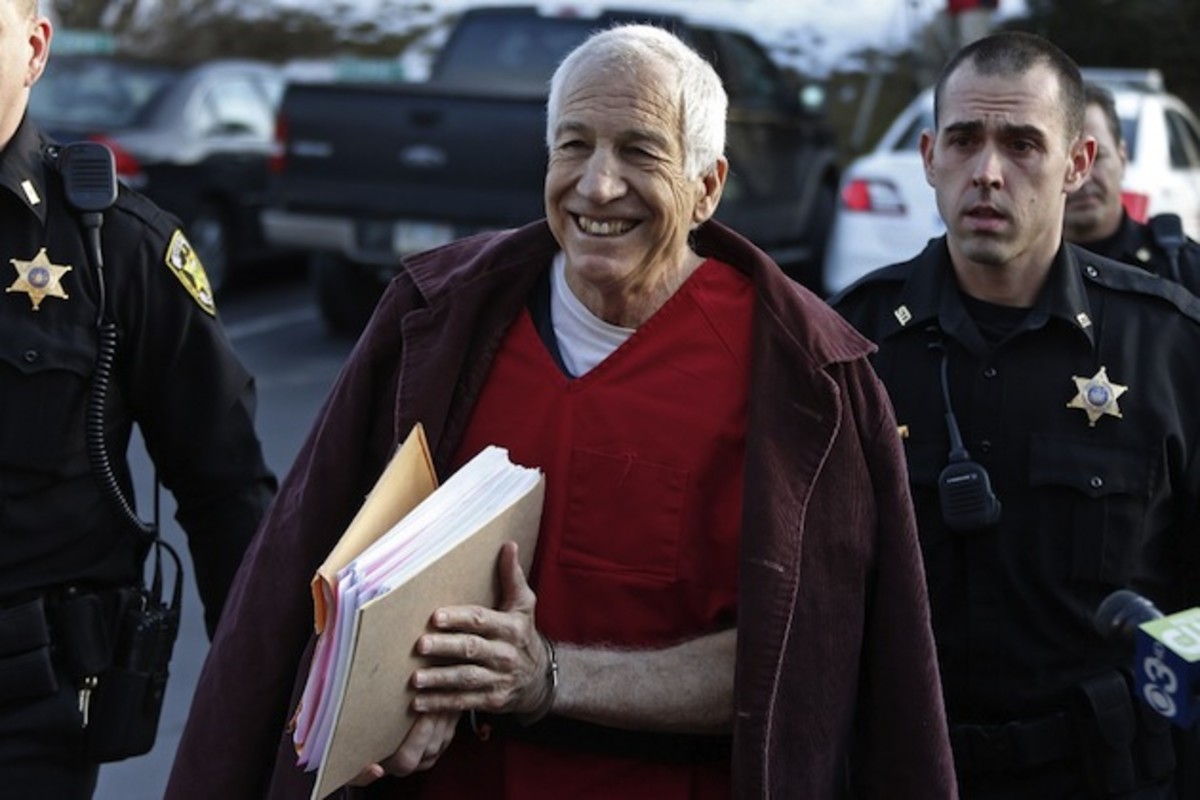
Victim 9, an 18-year-old boy, slight and barely out of high school, took the stand in the middle of the second week. Tall, skinny, dark-haired, soft-spoken Victim 9, wanting to be anywhere in the world but in that courtroom. With his shirt sleeves rolled above his elbows, he sat leaning forward in the witness box, looking pleadingly at silver-haired, sharp-tongued prosecutor Joe McGettigan to hurry this up, to get him out of here as quickly as possible, to find the damn guy guilty so everyone could move on.
He winced as he told the jury his story.
He was raped over and over again in Sandusky’s basement. He shivered and shook there, on the stand, as he recalled the details. McGettigan was gentle, fast, merciful. And then it was Amendola’s turn.
“Have you ever bled rectally from sex with the defendant?” he asked, and faced the boy, awaiting an answer. “Did you ever have blood stains on your underwear?”
And everyone there in that moment knew that nothing worse had ever been said, and against all the journalistic bones in my body, I cried.
The day the case went to the jury there, the news reporters cleared out and Bellefonte briefly returned to its life as a small town, basking in a summer evening. I drove out of town slowly, with the windows down, listening to the difference in sounds from the day to the night, watching as parents took their children for ice cream and couples strolled Allegheny Street past the empty courthouse. It was a quieter moment of heartbreak; not the gut reaction to the crime or the lingering horror, exactly, but something that was softly sad, the feeling that something had broken down in this place. There was a rupture here, the sense that it would never be as safe, that happiness would never feel quite as pure, that the dream life the people of Bellefonte kept sacred had been ravaged, stripped, brutalized.
The next day we waited again, until at last, at 9 p.m., the words were whispered around the courthouse, around the streets of Bellefonte: there might be a verdict. Crowds gathered as we grabbed our press passes and headed once more into the great white courthouse.
As the verdict was read I lost my breath. Guilty, guilty, guilty, guilty, guilty. Guilty, guilty, guilty. Guilty. Guilty.
Over and over again, Jerry Sandusky was found guilty — of nearly everything the state had charged him with. But no, he wasn’t just “found guilty.” We could say it now, we could assert it: he was guilty. There was relief. Sandusky did commit these crimes, according to the justice system we operated. Our prepared tables and sheets to mark which counts were guilty and which were not guilty were useless. Keeping count was easy: 45 guilty, three not guilty.
Sandusky would go to jail forever.
Inside the courtroom the knowledge rose up, clogging the air, filling all of the breathable space until the judge said “adjourned,” and the word flew down the marble steps from the second floor courtroom and the white courthouse doors burst open into the town, and all at once, from where I sat two stories up, Bellefonte heard the news.
A cheer erupted. It erupted and it grew louder and louder, the sound of exultation at the word ‘guilty.’ They shouted and cheered and hugged and by the time I got downstairs and out into the thick of the crowd I saw the tears. With the tears they let it all go: the anger and hurt, the betrayal, the danger. The culture had changed; the cultus born anew. Press conferences on the steps became pep rallies for the justice system and for the triumph of right over wrong.
Later, it would seem less perfect.
The courts had found Sandusky guilty of specific crimes committed against specific individuals; his punishment would suit those crimes. But the rupture of pain felt by the Centre County community, the horrific glare of the media spotlight and the pressure of being the focus of the national conversation on morality, the disappointment at community leaders, the sorrow for the children forsaken — none of it could be righted, could be fixed. The damage to Penn State’s name and legacy would not be forgotten.
In America, we have the court system, our measly and sometimes-effective way of bringing some small amount of legal justice to wrongs committed. But, of course, it is not enough. No legal punishment can account for the emotional pain wrought by Jerry Sandusky, and certainly there is no action that can right the nebulous, questionable actions of Joe Paterno, university president Graham Spanier, and other Penn State officials. The feeling in our guts of seeing so many humans failing to treat other humans well cannot be remedied by a million repetitions of the word ‘guilty,’ but it is all we have.
That night, on Allegheny Street, it is what the community of Bellefonte had, and it was no small thing.
9. Belief, or Not
Later, when there was not much left to feel, an investigation claimed Paterno likely knew what had happened and had hidden it to protect his program. His statue was covered in a blue tarp, a symbol of the community’s agreement that he was not, after all, their moral compass.
The faithful remained vigilant. They came to guard the bronze god, and their anger was still palpable, their outrage that Paterno had somehow been brought down for someone else’s crimes.
The NCAA allowed Penn State to keep playing football — an important fact for those with lives and jobs and emotions tied up in that university — but the throne had been dismantled, the kingdom broken up. The stadium, that great cathedral off University Drive, would forever cast its long shadow over campus.
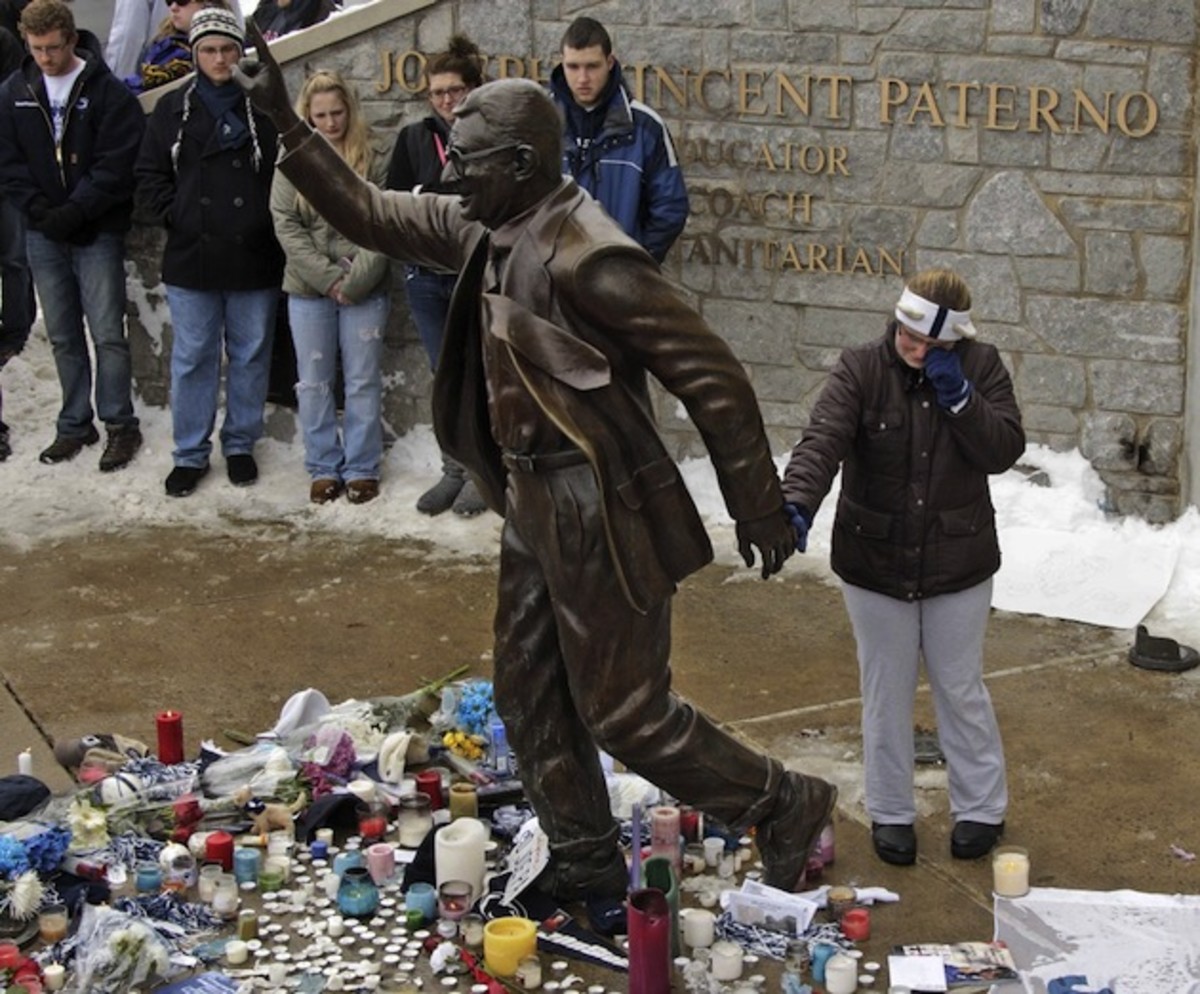
On a Saturday in August, around typical kick-off time, they came and took the statue away.
All that remained were the outlines where football players had once been, big black holes where bolts had once held them upright. In the spot where Paterno once stood, only a small dark circle — a shadow — remained.
(Ed. Note: This Colleen Curry story was originally published by The Cauldron in November 2014.)

